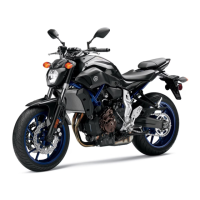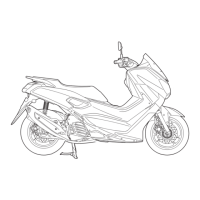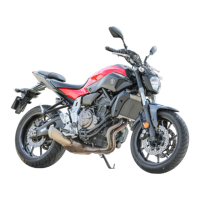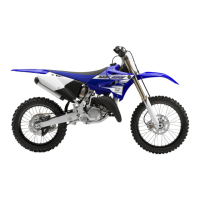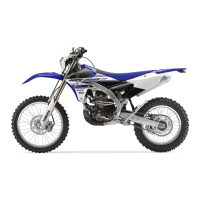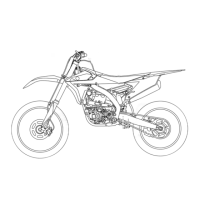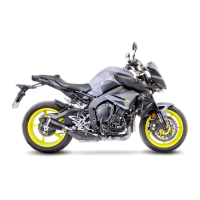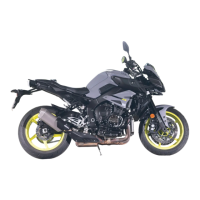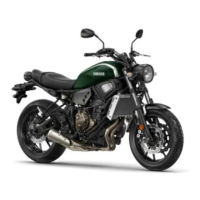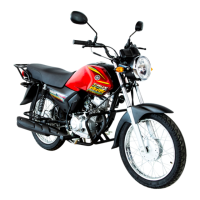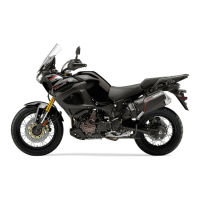Do you have a question about the Yamaha FZ-07 2016 and is the answer not in the manual?
Read this manual carefully and completely before operating this motorcycle.
The safety alert symbol warns of potential personal injury hazards.
A WARNING indicates a hazardous situation that could result in death or serious injury.
A NOTICE indicates special precautions to avoid damage to the vehicle or property.
A TIP provides key information to make procedures easier or clearer.
Details and descriptions for labels 1-6 on the vehicle, covering safety and tire information.
Details and descriptions for labels 7-10, including warnings and certification marks.
Owner's responsibility for safe operation and maintenance.
Performing pre-operation checks and riding safely.
Importance of helmets, jackets, and other protective gear.
Hazards of carbon monoxide and how to avoid poisoning.
How loading affects stability and maximum load limits.
Benefits and recommendations for using genuine Yamaha accessories.
Potential safety hazards associated with aftermarket parts and modifications.
Instructions for safely transporting the motorcycle in another vehicle.
Identification of key components on the left side of the motorcycle.
Identification of key components on the right side of the motorcycle.
Identification of controls and instruments on the handlebar.
Explains the operation and positions of the main switch and steering lock.
Explains the function of various indicator and warning lights on the meter.
Details on oil pressure, coolant temp, engine trouble, and ABS warning lights.
Description of the speedometer, tachometer, fuel meter, and other displays.
How to read and set the tachometer and clock on the meter unit.
Displays fuel level and indicates fuel-efficient operation.
Shows the current gear selection and neutral position.
How to cycle through odometer, tripmeters, fuel consumption, and temperature displays.
Calculates and displays fuel consumption in km/L or L/100 km.
Shows engine coolant and ambient air temperatures.
System for detecting electrical circuit problems and displaying error codes.
Adjusts the brightness level of the multi-function meter unit.
Details on pass, dimmer, turn signal, and horn switches.
Controls starting the engine and stopping it in emergencies.
Activates hazard lights for emergencies or warnings.
Operation of the clutch lever for disengaging and engaging the clutch.
Operation of the shift pedal for changing gears in the 6-speed transmission.
How to apply the front brake using the brake lever and adjust its position.
How to apply the rear brake using the brake pedal.
Explains the function and operation of the Anti-lock Brake System.
Instructions for opening and closing the fuel tank cap.
Safety warnings and instructions for refueling the motorcycle.
Recommended fuel type, octane rating, and tank capacity.
Information on using gasohol containing ethanol or methanol.
Checks and maintenance for the fuel tank breather and overflow hoses.
Information on the catalytic converter and precautions for its use.
Steps to remove and install the passenger seat.
Steps to remove the rider seat.
Steps to install the rider seat.
How to use the helmet holding cable to secure a helmet.
How to release a helmet secured by the holding cable.
Location and usage of the storage compartment under the seat.
How to adjust the spring preload on the shock absorber assembly.
Description and usage of the six luggage strap holders.
Proper use of the sidestand and its safety implications.
Functions of the sidestand, clutch, and neutral switches.
Procedure to check the operation of the ignition circuit cut-off system.
Information about the auxiliary DC connector for accessories.
Checks for fuel, engine oil, coolant, and front brake system before operation.
Checks for rear brake, clutch, throttle grip, and control cables.
Checks for drive chain, tires, pedals, and sidestand switch.
Procedure for starting the engine, including safety system requirements.
Explanation of gear shifting and recommended shift points.
Steps for starting from a stop and accelerating smoothly.
Procedure for slowing down and stopping the motorcycle.
Table showing recommended shift points for acceleration and deceleration.
Guidelines for breaking in the engine during the first 1600 km.
Safety guidelines for parking the motorcycle.
Explains why periodic inspection, adjustment, and lubrication are essential.
Information on emission control services and specialized requirements.
Location and use of the owner's tool kit for maintenance.
Schedule for emission control system maintenance items.
Schedule for general maintenance and lubrication tasks.
Checks and lubrication for tires, wheel bearings, and swingarm pivots.
Checks for drive chain and steering bearings.
Lubrication and checks for brake lever pivots and sidestand.
Checks for front fork and shock absorber operation and leaks.
Procedure for changing engine oil and replacing the oil filter cartridge.
Checks for cooling system hoses and coolant level.
Checks for brake switches and lubrication of control cables.
Checks for throttle grip and lights operation.
Procedures for changing brake fluid and replacing components.
How to check, gap, clean, and replace spark plugs.
How to check the engine oil level using the sight window.
Procedure for draining oil and replacing the oil filter cartridge.
Detailed steps for removing and installing the oil filter cartridge.
Refilling engine oil and tightening drain bolt and filter cartridge.
Recommended engine oil, quantity, and precautions for clutch slip.
How to check the coolant level in the reservoir on a cold engine.
Procedure for draining and refilling the coolant reservoir and radiator.
Recommended coolant mixture ratio, quantity, and type.
Checking the cooling system for coolant leaks after refilling.
Procedure for replacing the air filter element.
How to clean the air filter check hose.
Measuring and adjusting the throttle grip free play.
Importance of valve clearance and when to have it adjusted.
Importance of checking and adjusting tire air pressure on cold tires.
How to inspect tires for wear, damage, and age.
Approved tire sizes, manufacturers, and valve specifications.
Checking wheel rims for damage and the importance of balancing.
Procedure for measuring and adjusting clutch lever free play.
Ensuring there is no free play at the brake lever end.
How to adjust rear brake light switch for proper timing.
How to check brake pad wear using indicators.
How to check front brake fluid level and replenish if necessary.
Checking rear brake fluid level and warnings about maintenance.
Procedures for changing brake fluid and replacing components.
How to check drive chain slack and adjust if necessary.
Detailed steps for adjusting drive chain slack and wheel alignment.
Proper methods for cleaning and lubricating the drive chain.
Inspection and lubrication of control cables and their ends.
Operation check and lubrication of the throttle grip and cable.
Operation check and lubrication of brake and shift pedal pivots.
Operation check and lubrication of brake and clutch lever pivots.
Checking sidestand operation and lubrication of pivot points.
Lubrication of the pivoting points of the rear suspension.
Lubrication of the swingarm pivots.
Checking front fork condition and operation.
Checking steering bearings for wear or looseness.
Checking front and rear wheel bearings for play or smooth operation.
Information on VRLA battery maintenance, charging, and storage.
Location and replacement of fuses for the FZ07H model.
Location and replacement of fuses for the FZ07AH model.
Procedure for replacing the halogen headlight bulb.
Procedure for replacing the auxiliary light bulb.
Information on the LED brake/tail light.
Procedure for replacing a turn signal light bulb.
Procedure for replacing the turn signal light unit.
Procedure for replacing the license plate light bulb.
Methods for safely supporting the motorcycle for maintenance.
Steps to remove the front wheel for non-ABS models.
Steps to install the front wheel for non-ABS models.
Steps to remove the rear wheel for non-ABS models.
Steps to install the rear wheel for non-ABS models.
General advice on troubleshooting and using genuine Yamaha parts.
Charts to diagnose starting issues related to fuel, battery, ignition, and compression.
Procedure for diagnosing and addressing engine overheating issues.
Precautions for cleaning and maintaining matte colored parts.
Importance of care, cleaning procedures, and product usage warnings.
Warnings and advice for cleaning plastic parts safely.
Steps for cleaning after riding in rain, near sea, or on salt-sprayed roads.
Applying corrosion protection spray and touching up paint damage.
Guidelines for storing the motorcycle in a cool, dry place.
Steps to protect the motorcycle's cylinders and other parts for long-term storage.
Specifications for overall length, width, height, seat height, weight, and engine details.
Specifications for coolant quantity, air filter element type, and fuel.
Gear ratios, frame type, tire sizes, and wheel types.
Specifications for front and rear brakes, and suspension system.
Details on battery model, capacity, and headlight bulb wattage.
Specifications for indicator lights, warning lights, and fuses.
Recording vehicle, engine serial, and key identification numbers.
Location and purpose of the model label and key identification number.
Information on the label related to exhaust emissions.
Location of the diagnostic connector for service.
A chart to record periodic maintenance intervals and services.
Sections A, B, C: Warranty policy, subsequent owner, and repair procedures.
Sections D, E: Warranty exclusions and emissions control system warranty.
Section F: Original equipment tire warranty and motorcycle storage.
Read this manual carefully and completely before operating this motorcycle.
The safety alert symbol warns of potential personal injury hazards.
A WARNING indicates a hazardous situation that could result in death or serious injury.
A NOTICE indicates special precautions to avoid damage to the vehicle or property.
A TIP provides key information to make procedures easier or clearer.
Details and descriptions for labels 1-6 on the vehicle, covering safety and tire information.
Details and descriptions for labels 7-10, including warnings and certification marks.
Owner's responsibility for safe operation and maintenance.
Performing pre-operation checks and riding safely.
Importance of helmets, jackets, and other protective gear.
Hazards of carbon monoxide and how to avoid poisoning.
How loading affects stability and maximum load limits.
Benefits and recommendations for using genuine Yamaha accessories.
Potential safety hazards associated with aftermarket parts and modifications.
Instructions for safely transporting the motorcycle in another vehicle.
Identification of key components on the left side of the motorcycle.
Identification of key components on the right side of the motorcycle.
Identification of controls and instruments on the handlebar.
Explains the operation and positions of the main switch and steering lock.
Explains the function of various indicator and warning lights on the meter.
Details on oil pressure, coolant temp, engine trouble, and ABS warning lights.
Description of the speedometer, tachometer, fuel meter, and other displays.
How to read and set the tachometer and clock on the meter unit.
Displays fuel level and indicates fuel-efficient operation.
Shows the current gear selection and neutral position.
How to cycle through odometer, tripmeters, fuel consumption, and temperature displays.
Calculates and displays fuel consumption in km/L or L/100 km.
Shows engine coolant and ambient air temperatures.
System for detecting electrical circuit problems and displaying error codes.
Adjusts the brightness level of the multi-function meter unit.
Details on pass, dimmer, turn signal, and horn switches.
Controls starting the engine and stopping it in emergencies.
Activates hazard lights for emergencies or warnings.
Operation of the clutch lever for disengaging and engaging the clutch.
Operation of the shift pedal for changing gears in the 6-speed transmission.
How to apply the front brake using the brake lever and adjust its position.
How to apply the rear brake using the brake pedal.
Explains the function and operation of the Anti-lock Brake System.
Instructions for opening and closing the fuel tank cap.
Safety warnings and instructions for refueling the motorcycle.
Recommended fuel type, octane rating, and tank capacity.
Information on using gasohol containing ethanol or methanol.
Checks and maintenance for the fuel tank breather and overflow hoses.
Information on the catalytic converter and precautions for its use.
Steps to remove and install the passenger seat.
Steps to remove the rider seat.
Steps to install the rider seat.
How to use the helmet holding cable to secure a helmet.
How to release a helmet secured by the holding cable.
Location and usage of the storage compartment under the seat.
How to adjust the spring preload on the shock absorber assembly.
Description and usage of the six luggage strap holders.
Proper use of the sidestand and its safety implications.
Functions of the sidestand, clutch, and neutral switches.
Procedure to check the operation of the ignition circuit cut-off system.
Information about the auxiliary DC connector for accessories.
Checks for fuel, engine oil, coolant, and front brake system before operation.
Checks for rear brake, clutch, throttle grip, and control cables.
Checks for drive chain, tires, pedals, and sidestand switch.
Procedure for starting the engine, including safety system requirements.
Explanation of gear shifting and recommended shift points.
Steps for starting from a stop and accelerating smoothly.
Procedure for slowing down and stopping the motorcycle.
Table showing recommended shift points for acceleration and deceleration.
Guidelines for breaking in the engine during the first 1600 km.
Safety guidelines for parking the motorcycle.
Explains why periodic inspection, adjustment, and lubrication are essential.
Information on emission control services and specialized requirements.
Location and use of the owner's tool kit for maintenance.
Schedule for emission control system maintenance items.
Schedule for general maintenance and lubrication tasks.
Checks and lubrication for tires, wheel bearings, and swingarm pivots.
Checks for drive chain and steering bearings.
Lubrication and checks for brake lever pivots and sidestand.
Checks for front fork and shock absorber operation and leaks.
Procedure for changing engine oil and replacing the oil filter cartridge.
Checks for cooling system hoses and coolant level.
Checks for brake switches and lubrication of control cables.
Checks for throttle grip and lights operation.
Procedures for changing brake fluid and replacing components.
How to check, gap, clean, and replace spark plugs.
How to check the engine oil level using the sight window.
Procedure for draining oil and replacing the oil filter cartridge.
Detailed steps for removing and installing the oil filter cartridge.
Refilling engine oil and tightening drain bolt and filter cartridge.
Recommended engine oil, quantity, and precautions for clutch slip.
How to check the coolant level in the reservoir on a cold engine.
Procedure for draining and refilling the coolant reservoir and radiator.
Recommended coolant mixture ratio, quantity, and type.
Checking the cooling system for coolant leaks after refilling.
Procedure for replacing the air filter element.
How to clean the air filter check hose.
Measuring and adjusting the throttle grip free play.
Importance of valve clearance and when to have it adjusted.
Importance of checking and adjusting tire air pressure on cold tires.
How to inspect tires for wear, damage, and age.
Approved tire sizes, manufacturers, and valve specifications.
Checking wheel rims for damage and the importance of balancing.
Procedure for measuring and adjusting clutch lever free play.
Ensuring there is no free play at the brake lever end.
How to adjust rear brake light switch for proper timing.
How to check brake pad wear using indicators.
How to check front brake fluid level and replenish if necessary.
Checking rear brake fluid level and warnings about maintenance.
Procedures for changing brake fluid and replacing components.
How to check drive chain slack and adjust if necessary.
Detailed steps for adjusting drive chain slack and wheel alignment.
Proper methods for cleaning and lubricating the drive chain.
Inspection and lubrication of control cables and their ends.
Operation check and lubrication of the throttle grip and cable.
Operation check and lubrication of brake and shift pedal pivots.
Operation check and lubrication of brake and clutch lever pivots.
Checking sidestand operation and lubrication of pivot points.
Lubrication of the pivoting points of the rear suspension.
Lubrication of the swingarm pivots.
Checking front fork condition and operation.
Checking steering bearings for wear or looseness.
Checking front and rear wheel bearings for play or smooth operation.
Information on VRLA battery maintenance, charging, and storage.
Location and replacement of fuses for the FZ07H model.
Location and replacement of fuses for the FZ07AH model.
Procedure for replacing the halogen headlight bulb.
Procedure for replacing the auxiliary light bulb.
Information on the LED brake/tail light.
Procedure for replacing a turn signal light bulb.
Procedure for replacing the turn signal light unit.
Procedure for replacing the license plate light bulb.
Methods for safely supporting the motorcycle for maintenance.
Steps to remove the front wheel for non-ABS models.
Steps to install the front wheel for non-ABS models.
Steps to remove the rear wheel for non-ABS models.
Steps to install the rear wheel for non-ABS models.
General advice on troubleshooting and using genuine Yamaha parts.
Charts to diagnose starting issues related to fuel, battery, ignition, and compression.
Procedure for diagnosing and addressing engine overheating issues.
Precautions for cleaning and maintaining matte colored parts.
Importance of care, cleaning procedures, and product usage warnings.
Warnings and advice for cleaning plastic parts safely.
Steps for cleaning after riding in rain, near sea, or on salt-sprayed roads.
Applying corrosion protection spray and touching up paint damage.
Guidelines for storing the motorcycle in a cool, dry place.
Steps to protect the motorcycle's cylinders and other parts for long-term storage.
Specifications for overall length, width, height, seat height, weight, and engine details.
Specifications for coolant quantity, air filter element type, and fuel.
Gear ratios, frame type, tire sizes, and wheel types.
Specifications for front and rear brakes, and suspension system.
Details on battery model, capacity, and headlight bulb wattage.
Specifications for indicator lights, warning lights, and fuses.
Recording vehicle, engine serial, and key identification numbers.
Location and purpose of the model label and key identification number.
Information on the label related to exhaust emissions.
Location of the diagnostic connector for service.
A chart to record periodic maintenance intervals and services.
Sections A, B, C: Warranty policy, subsequent owner, and repair procedures.
Sections D, E: Warranty exclusions and emissions control system warranty.
Section F: Original equipment tire warranty and motorcycle storage.
| Displacement | 689cc |
|---|---|
| Bore x Stroke | 80.0mm x 68.6mm |
| Compression Ratio | 11.5:1 |
| Fuel System | Fuel Injection |
| Ignition | TCI: Transistor Controlled Ignition |
| Transmission | 6-speed; multiplate wet clutch |
| Final Drive | Chain |
| Front Tire | 120/70ZR17 |
| Rear Tire | 180/55ZR17 |
| Seat Height | 31.7 in |
| Wheelbase | 55.1 in |
| Trail | 3.5 in |
| Ground Clearance | 5.5 in |
| Fuel Capacity | 3.7 gal |
| Wet Weight | 397 lb |
| Engine Type | Liquid-cooled, 4-stroke, DOHC, 4-valve |
| Front Suspension | 41mm fork; 5.1-in travel |
| Rear Suspension | Single shock; 5.1-in travel |
| Front Brakes | Dual hydraulic disc, 282mm |
| Rear Brakes | Hydraulic disc, 245mm |
